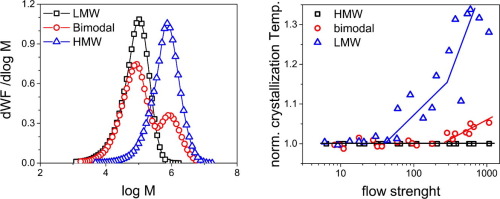当前位置:
X-MOL 学术
›
Eur. Polym. J.
›
论文详情
Our official English website, www.x-mol.net, welcomes your feedback! (Note: you will need to create a separate account there.)
Application of a multi-phase multi-morphology crystallization model to isotactic polypropylenes with different molecular weight distributions
European Polymer Journal ( IF 6 ) Pub Date : 2017-12-01 , DOI: 10.1016/j.eurpolymj.2017.09.042 E.M. Troisi , S.A.J.J. Arntz , P.C. Roozemond , A.H. Tsou , G.W.M. Peters
European Polymer Journal ( IF 6 ) Pub Date : 2017-12-01 , DOI: 10.1016/j.eurpolymj.2017.09.042 E.M. Troisi , S.A.J.J. Arntz , P.C. Roozemond , A.H. Tsou , G.W.M. Peters

|
Abstract Flow-induced crystallization at elevated pressure of a set of metallocene isotactic polypropylenes (iPP) possessing different molecular weight distributions is studied using extended dilatometry experiments in an apparatus able to apply elevated pressure (up to 1200 bar) and strong shear flow (shear rates up to 180 s−1). The effect of flow on the crystallization temperature was quantified and the samples were analyzed using X-ray diffraction to measure the relative amounts of different crystal phases. The experimental results were used to test a flow induced crystallization model framework recently developed in our group which can describe the complex crystallization behavior of iPP and includes formation of multiple morphologies (spherulites, shish-kebab structure with lamellar branching) and crystal phases ( α , β and γ ). Almost all model parameters were left unchanged, except for the temperature description of the quiescent crystal growth rate and nucleation density (experimentally measured using optical microscopy) and an extra parameter which takes into account the fraction of high molecular weight for the creation of flow-induced nuclei. The model describes rather good the experimentally observed trends for what regards crystallization temperature and amount of α and γ -phase but substantial discrepancies were found in the amount of β -phase formed. This could be related to the presence of 2,1 insertion errors in metallocene samples which could inhibit the formation of this crystal phase.
中文翻译:

多相多形貌结晶模型在不同分子量分布的全同立构聚丙烯中的应用
摘要 在能够施加高压(高达 1200 bar)和强剪切流(剪切速率)的设备中,使用扩展膨胀试验研究了一组具有不同分子量分布的茂金属全同立构聚丙烯 (iPP) 在高压下的流动诱导结晶180 s−1)。量化流动对结晶温度的影响,并使用 X 射线衍射分析样品以测量不同晶相的相对量。实验结果用于测试我们小组最近开发的流动诱导结晶模型框架,该框架可以描述 iPP 的复杂结晶行为,包括形成多种形态(球晶、具有层状分支的烤肉串结构)和晶相(α、 β 和 γ )。几乎所有模型参数都保持不变,除了静态晶体生长速率和成核密度的温度描述(使用光学显微镜实验测量)和一个额外的参数,该参数考虑了用于产生流动诱导的高分子量的分数。核。该模型很好地描述了实验观察到的关于结晶温度和 α 相和 γ 相量的趋势,但发现形成的 β 相量存在很大差异。这可能与茂金属样品中存在 2,1 插入错误有关,这可能会抑制该晶相的形成。除了静态晶体生长速率和成核密度的温度描述(使用光学显微镜实验测量)和一个额外的参数,该参数考虑了用于产生流动诱导核的高分子量部分。该模型很好地描述了实验观察到的关于结晶温度和 α 相和 γ 相量的趋势,但发现形成的 β 相量存在很大差异。这可能与茂金属样品中存在 2,1 插入错误有关,这可能会抑制该晶相的形成。除了静态晶体生长速率和成核密度的温度描述(使用光学显微镜实验测量)和一个额外的参数,该参数考虑了用于产生流动诱导核的高分子量部分。该模型很好地描述了实验观察到的关于结晶温度和 α 相和 γ 相量的趋势,但发现形成的 β 相量存在很大差异。这可能与茂金属样品中存在 2,1 插入错误有关,这可能会抑制该晶相的形成。该模型很好地描述了实验观察到的关于结晶温度和 α 相和 γ 相量的趋势,但发现形成的 β 相量存在很大差异。这可能与茂金属样品中存在 2,1 插入错误有关,这可能会抑制该晶相的形成。该模型很好地描述了实验观察到的关于结晶温度和 α 相和 γ 相量的趋势,但发现形成的 β 相量存在很大差异。这可能与茂金属样品中存在 2,1 插入错误有关,这可能会抑制该晶相的形成。
更新日期:2017-12-01
中文翻译:

多相多形貌结晶模型在不同分子量分布的全同立构聚丙烯中的应用
摘要 在能够施加高压(高达 1200 bar)和强剪切流(剪切速率)的设备中,使用扩展膨胀试验研究了一组具有不同分子量分布的茂金属全同立构聚丙烯 (iPP) 在高压下的流动诱导结晶180 s−1)。量化流动对结晶温度的影响,并使用 X 射线衍射分析样品以测量不同晶相的相对量。实验结果用于测试我们小组最近开发的流动诱导结晶模型框架,该框架可以描述 iPP 的复杂结晶行为,包括形成多种形态(球晶、具有层状分支的烤肉串结构)和晶相(α、 β 和 γ )。几乎所有模型参数都保持不变,除了静态晶体生长速率和成核密度的温度描述(使用光学显微镜实验测量)和一个额外的参数,该参数考虑了用于产生流动诱导的高分子量的分数。核。该模型很好地描述了实验观察到的关于结晶温度和 α 相和 γ 相量的趋势,但发现形成的 β 相量存在很大差异。这可能与茂金属样品中存在 2,1 插入错误有关,这可能会抑制该晶相的形成。除了静态晶体生长速率和成核密度的温度描述(使用光学显微镜实验测量)和一个额外的参数,该参数考虑了用于产生流动诱导核的高分子量部分。该模型很好地描述了实验观察到的关于结晶温度和 α 相和 γ 相量的趋势,但发现形成的 β 相量存在很大差异。这可能与茂金属样品中存在 2,1 插入错误有关,这可能会抑制该晶相的形成。除了静态晶体生长速率和成核密度的温度描述(使用光学显微镜实验测量)和一个额外的参数,该参数考虑了用于产生流动诱导核的高分子量部分。该模型很好地描述了实验观察到的关于结晶温度和 α 相和 γ 相量的趋势,但发现形成的 β 相量存在很大差异。这可能与茂金属样品中存在 2,1 插入错误有关,这可能会抑制该晶相的形成。该模型很好地描述了实验观察到的关于结晶温度和 α 相和 γ 相量的趋势,但发现形成的 β 相量存在很大差异。这可能与茂金属样品中存在 2,1 插入错误有关,这可能会抑制该晶相的形成。该模型很好地描述了实验观察到的关于结晶温度和 α 相和 γ 相量的趋势,但发现形成的 β 相量存在很大差异。这可能与茂金属样品中存在 2,1 插入错误有关,这可能会抑制该晶相的形成。



























 京公网安备 11010802027423号
京公网安备 11010802027423号